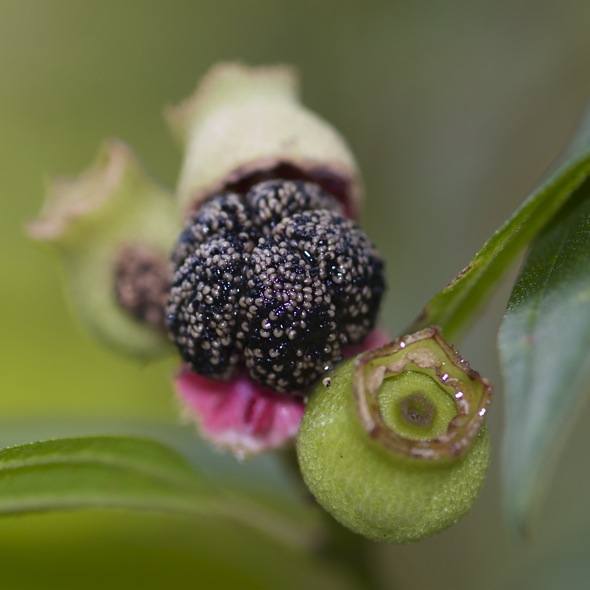Sendudok (Melastoma malabathricum) is misleadingly called Singapore Rhododendron. It does not originates from Singapore and the flowers in no way resemble those of rhododendron. This is a common shrub that colonise bare areas, sides of roads, gardens and parks. The plant grows rapidly, to flower and fruit throughout the year.
The flowers are light to dark pink, showy and open in the morning, displaying the five short yellow and five long mauve stamens (above). Each stamen consists of a stalk bearing the anther packed with pollen. At he tip of the anther is a small pore. The single style can be distinguished from its green tip (see above).
Two species of Carpenter Bees visit the flowers to collect pollen – Xylocopa confusa which has a yellow patch on its back (above) and Xylocopa latipes, which is all black (below). These large bees practice buzz pollination. The bee lands on the flower and its beating wings causes a resonant frequency that triggers the stamens to shoot out their pollen onto the underside of the bee. In this way these bees help in the pollination of the flowers. See also HERE.
Other smaller bees that have also been seen around the flowers are Asian Hive Bee (Apis cerena) (below left) and Stingless Bee (Trigona sp.) (below right). Note that the pollen basket of both the back legs of the Stingless Bee are packed full of white pollen.
Blue-bearded Bee-eater (Nyctyornis athertoni) has been documented taking a carpenter bee LINK. I am sure other bee-eaters similarly predate on the different species of bees as well.
The fruit is a berry-like capsule that splits open to expose the mass of blackish pulp embedded with numerous small seeds (above). Birds love the fruits. These include Scarlet-backed Flowerpecker (Dicaeum cruentatum) LINK, Orange-bellied Flowerpecker (Dicaeum trigonostigma) LINK and Yellow-vented Bubul (Pycnonotus goiavier) LINK.
Red-crowned Barbets (Megalaima rafflesii) have been known to collect the fruits to feed their chicks LINK.
YC Wee
Singapore
May 2014


![Melastoma fl-parts [wyc]](https://besgroup.org/wp-content/uploads/Melastoma-fl-parts-wyc.jpg)
![Xylocopa confusa-Melastoma fl [wyc] - 08](https://besgroup.org/wp-content/uploads/Xylocopa-confusa-Melastoma-fl-wyc-08.jpg)
![Xylocopa confusa-Melastoma fl [wyc] - 09](https://besgroup.org/wp-content/uploads/Xylocopa-confusa-Melastoma-fl-wyc-09.jpg)
![Xylocopa latipes-Melastoma fl [wyc] - 03](https://besgroup.org/wp-content/uploads/Xylocopa-latipes-Melastoma-fl-wyc-03.jpg)
![Xylocopa latipes-Melastoma fl [wyc] - 15](https://besgroup.org/wp-content/uploads/Xylocopa-latipes-Melastoma-fl-wyc-15.jpg)
![Apis dorsata -Melastoma [wyc] 1](https://besgroup.org/wp-content/uploads/Apis-dorsata-Melastoma-wyc-1.jpg)
![Trigona sp-Melastoma fl [wyc] - 2](https://besgroup.org/wp-content/uploads/Trigona-sp-Melastoma-fl-wyc-2.jpg)








5 Responses
email me all the information of birds, plants etc
thanks